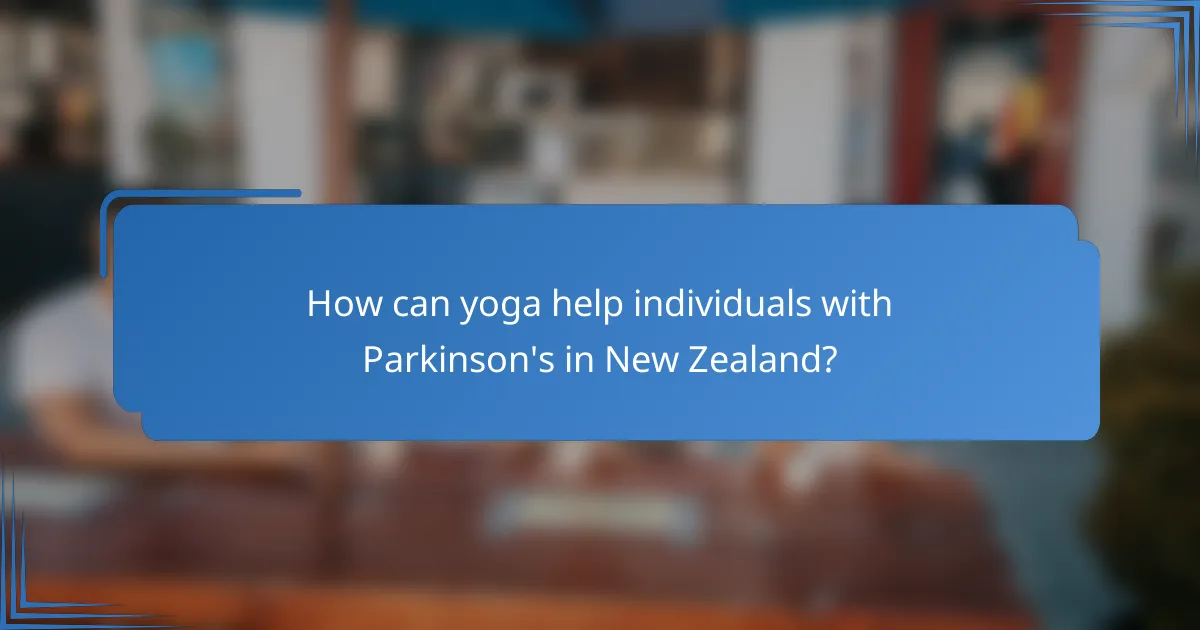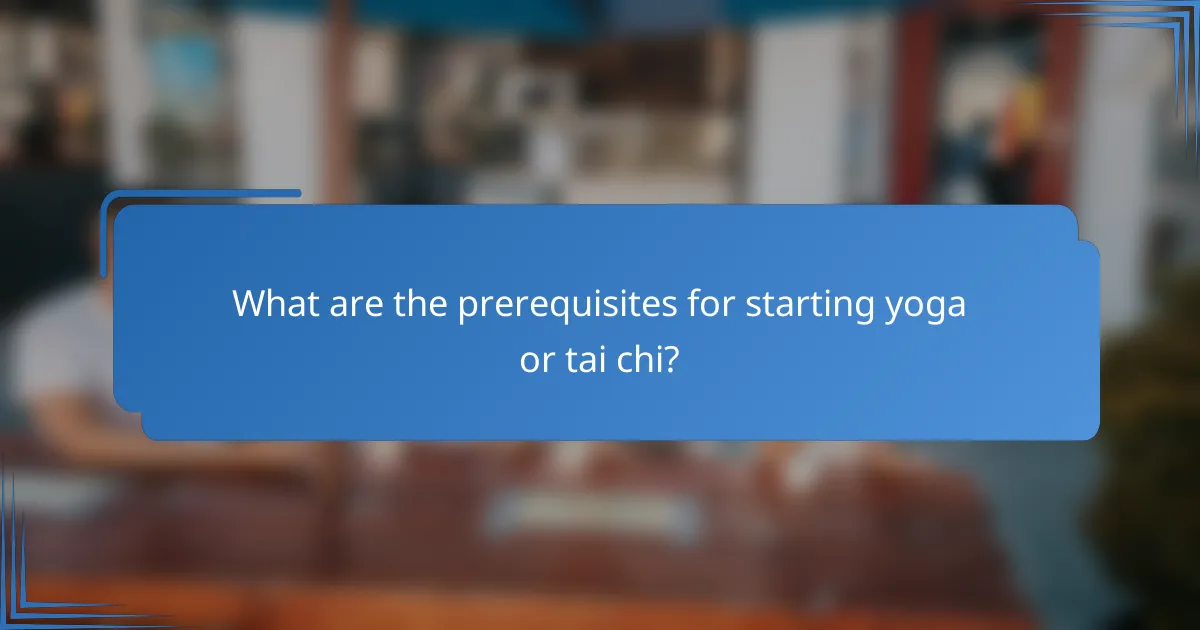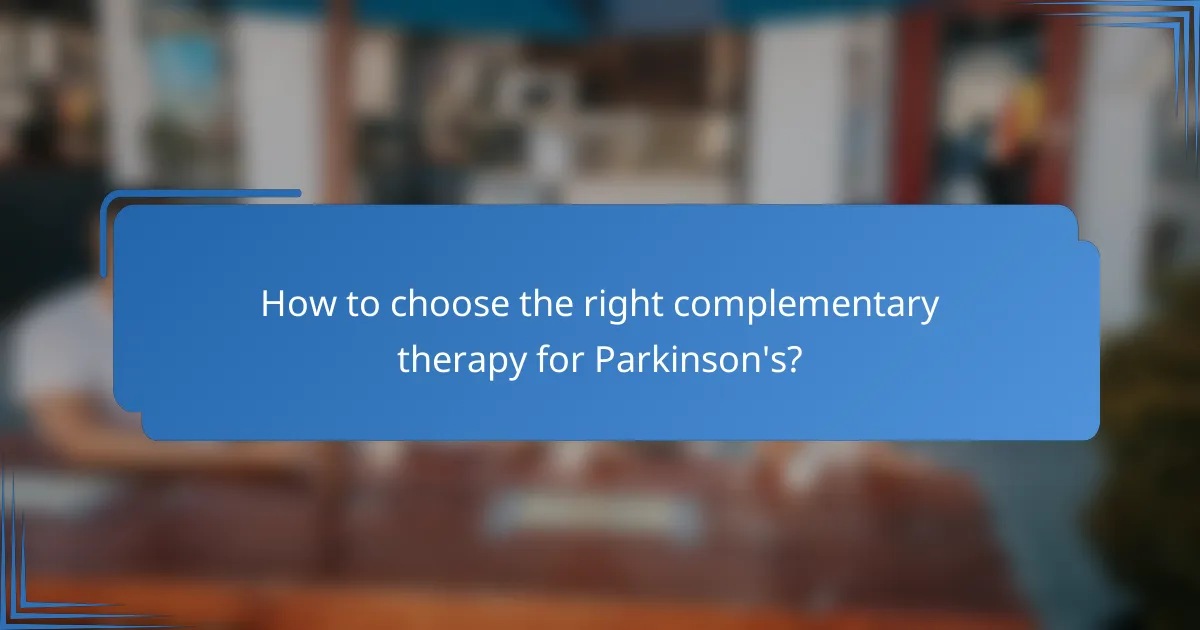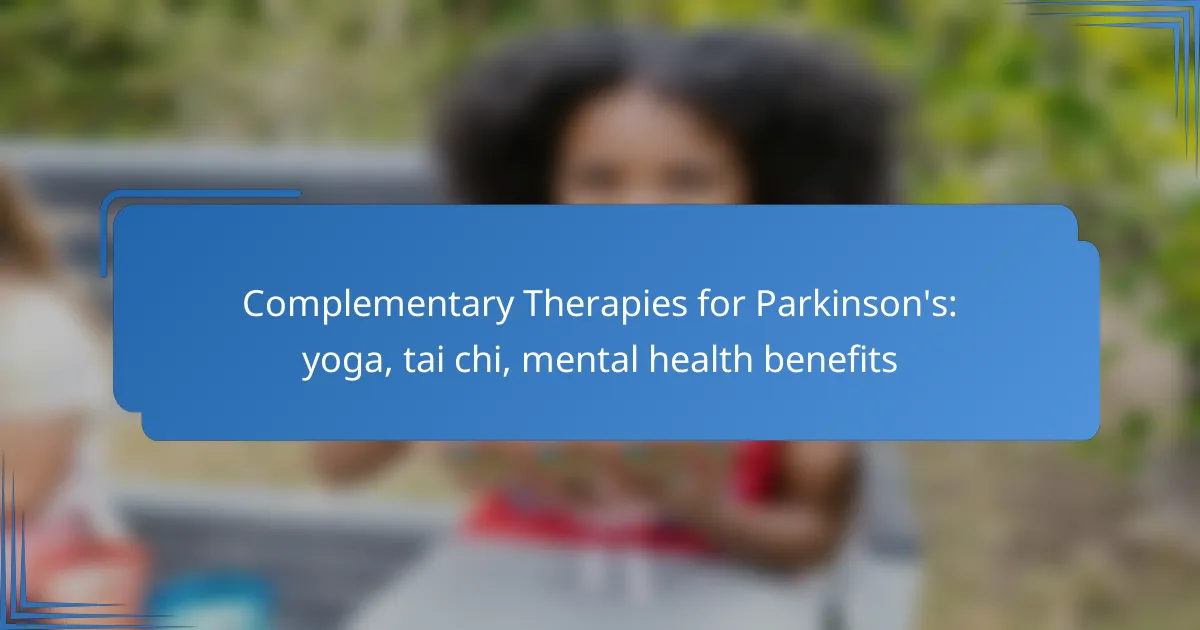Complementary therapies such as yoga and tai chi offer valuable benefits for individuals with Parkinson’s disease, enhancing both physical function and mental health. These practices not only improve stability and balance but also promote emotional well-being by reducing anxiety and depression. By fostering mindfulness and a sense of community, yoga and tai chi can play a crucial role in supporting those living with this condition.

How can yoga help individuals with Parkinson’s in New Zealand?
Yoga can significantly benefit individuals with Parkinson’s in New Zealand by improving physical function and mental health. It offers a holistic approach that addresses both the physical and emotional challenges faced by those living with this condition.
Improves flexibility and balance
Yoga enhances flexibility and balance, which are often compromised in individuals with Parkinson’s. Through gentle stretching and focused movements, participants can increase their range of motion and stability, reducing the risk of falls.
Incorporating poses like Tree Pose or Warrior II can be particularly beneficial. These poses help strengthen the core and lower body, which are crucial for maintaining balance.
Reduces stress and anxiety
Practicing yoga can effectively reduce stress and anxiety levels in individuals with Parkinson’s. The combination of mindful breathing and meditation techniques promotes relaxation and helps manage the emotional symptoms associated with the disease.
Regular sessions can lead to improved mood and a greater sense of calm. Simple practices such as deep breathing exercises or guided meditations can be easily integrated into daily routines.
Enhances overall well-being
Yoga contributes to overall well-being by fostering a sense of community and support among participants. Group classes provide social interaction, which can alleviate feelings of isolation often experienced by those with Parkinson’s.
Additionally, the physical activity involved in yoga can improve sleep quality and energy levels. Engaging in yoga regularly can lead to a more positive outlook on life, enhancing both mental and physical health.

What are the benefits of tai chi for Parkinson’s patients?
Tai chi offers several benefits for Parkinson’s patients, particularly in enhancing physical stability and mental clarity. This gentle martial art focuses on slow, controlled movements, which can help improve balance and reduce the risk of falls.
Promotes stability and coordination
Tai chi emphasizes slow, deliberate movements that enhance stability and coordination. By practicing these movements regularly, Parkinson’s patients can improve their balance, which is crucial for preventing falls that can lead to serious injuries.
Classes often include exercises that focus on shifting weight and maintaining posture, helping participants develop a better sense of body awareness. This can be particularly beneficial for those experiencing motor symptoms associated with Parkinson’s.
Boosts mental focus and clarity
Engaging in tai chi requires concentration and mindfulness, which can significantly boost mental focus and clarity for Parkinson’s patients. The meditative aspects of the practice encourage participants to stay present, reducing anxiety and improving overall mental well-being.
Regular practice may help enhance cognitive function, as the combination of movement and mental engagement stimulates brain activity. This can lead to improved memory and decision-making skills over time.
Encourages social interaction
Tai chi classes often foster a sense of community, providing opportunities for social interaction among participants. This social aspect can be particularly beneficial for Parkinson’s patients, who may experience isolation due to their condition.
Joining a class can help individuals build supportive relationships, share experiences, and motivate each other in their practice. This social engagement can enhance emotional health and contribute to a more positive outlook on life.

How do complementary therapies improve mental health in Parkinson’s?
Complementary therapies like yoga and tai chi can significantly enhance mental health in individuals with Parkinson’s by reducing symptoms of anxiety and depression, while promoting overall emotional well-being. These practices foster a sense of community and mindfulness, which are essential for mental resilience.
Alleviates symptoms of depression
Engaging in complementary therapies can help alleviate symptoms of depression commonly experienced by those with Parkinson’s. Yoga and tai chi incorporate physical movement, which releases endorphins and can improve mood. Regular practice may lead to noticeable reductions in depressive symptoms over time.
Many practitioners report feeling more connected to their bodies and emotions, which can combat feelings of isolation. Group classes can also provide social support, further enhancing mental health outcomes.
Enhances emotional resilience
Complementary therapies contribute to emotional resilience by teaching coping strategies and promoting relaxation. Techniques such as deep breathing and mindfulness, often used in yoga and tai chi, can help individuals manage stress more effectively. This resilience is crucial for navigating the challenges of living with Parkinson’s.
Practicing these therapies regularly can foster a positive mindset, enabling individuals to face daily challenges with greater confidence. Participants often find that they are better equipped to handle emotional ups and downs.
Supports cognitive function
Complementary therapies can support cognitive function in individuals with Parkinson’s by enhancing focus and memory. The meditative aspects of yoga and tai chi encourage mental clarity, which can be beneficial for cognitive health. Engaging in these activities may slow cognitive decline associated with the disease.
Incorporating exercises that challenge coordination and balance can also stimulate brain activity. This holistic approach not only improves physical health but also promotes mental sharpness, making it easier to engage in daily tasks and social interactions.

What are the prerequisites for starting yoga or tai chi?
Before starting yoga or tai chi, individuals should ensure they are physically and mentally prepared. This includes consulting with healthcare providers and assessing their physical capabilities to tailor the practice to their needs.
Consultation with healthcare providers
Consulting with healthcare providers is essential before beginning yoga or tai chi, especially for individuals with Parkinson’s disease. A healthcare professional can provide personalized advice based on medical history, current health status, and any specific limitations.
During this consultation, patients should discuss their symptoms, medications, and any concerns about physical activity. This dialogue helps ensure that the chosen practice is safe and beneficial.
Assessment of physical capabilities
Assessing physical capabilities is crucial for safely engaging in yoga or tai chi. Individuals should evaluate their balance, flexibility, strength, and endurance to determine which movements are appropriate. This assessment can be done through self-evaluation or with the help of a physical therapist.
It’s advisable to start with gentle movements and gradually progress as comfort and confidence increase. Keeping a record of improvements can help motivate participants and guide adjustments in their practice.

How to choose the right complementary therapy for Parkinson’s?
Choosing the right complementary therapy for Parkinson’s involves understanding personal preferences, specific needs, and the availability of suitable classes. It’s essential to consider how each therapy aligns with individual goals, such as improving mobility or enhancing mental well-being.
Consider individual preferences and needs
When selecting a complementary therapy, personal preferences play a crucial role. For instance, some individuals may find yoga’s focus on flexibility and mindfulness appealing, while others might prefer the dynamic movements of tai chi. Identifying what resonates with you can enhance motivation and commitment.
Additionally, consider any physical limitations or health concerns. For example, if balance is an issue, tai chi may be more beneficial due to its emphasis on slow, controlled movements. Engaging in a therapy that feels comfortable and enjoyable can lead to better outcomes.
Evaluate accessibility of classes
Access to classes is a key factor in choosing a complementary therapy. Look for local studios or community centers that offer yoga or tai chi specifically tailored for individuals with Parkinson’s. Many places may provide classes designed for different skill levels, ensuring that everyone can participate safely.
Check the schedule and frequency of classes as well. Consistency is important for progress, so finding sessions that fit into your routine is essential. If in-person classes are not feasible, consider online options, which can provide flexibility and convenience.

What are the available resources for complementary therapies in New Zealand?
In New Zealand, various resources are available for complementary therapies such as yoga and tai chi, which can benefit individuals with Parkinson’s disease. These resources include local community centers offering classes and online platforms for virtual sessions, making it easier to access these therapies.
Local community centers offering classes
Many community centers across New Zealand provide classes specifically designed for individuals with Parkinson’s. These classes often focus on yoga and tai chi, promoting flexibility, balance, and mental well-being. Participants can expect a supportive environment where instructors are trained to accommodate varying levels of ability.
To find a local community center, check websites like the New Zealand Parkinson’s Association or local council listings. Classes typically range from weekly to bi-weekly sessions, allowing participants to engage regularly without overwhelming their schedules.
Online platforms for virtual sessions
Online platforms have become increasingly popular for accessing complementary therapies, especially for those who may have mobility challenges. Websites and apps offer virtual yoga and tai chi classes that can be attended from the comfort of home. This flexibility allows individuals to choose sessions that fit their personal schedules.
When selecting an online platform, look for those that provide classes tailored for Parkinson’s patients, ensuring the content is suitable and safe. Many platforms offer free trials or low-cost subscriptions, making it accessible for various budgets. Popular options include YouTube channels dedicated to Parkinson’s-friendly exercises and specialized health websites.
